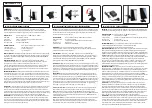
Introduction to the MA2000 System
MobileAccess2000 TSX System Architecture
MA2000 Installation and Configuration Guide
5
Figure
1-2. System Architecture
Figure
13 shows a basic block diagram of the system operation. On the downlink, services from
the BTS/BDA are transferred via interface to the Base Units (BUs). The interface, which may be
passive (i.e. Interface Box) or active (RIU), is used to attenuate the RF signals to the required
levels, converge them and distribute them to the BUs.
The BUs are wideband – they are not
service specific.
At the BUs, the RF signals are converted to optical signals and transmitted over the optic fiber to
(service-specific) RUs at the remote locations. At the remote locations, the RUs supported by the
hub (MRC or Lite) reconvert the optical signal to RF. The hub elements converge the voice
services together with 802.11 a/b/g data services (if MA850/MA860 units are installed) and
distribute them over the coax antenna infrastructure. The MA SC-450 (in installations with
remote management) provides monitoring and control of all active system elements.Application
Examples
Figure
14 shows an example of an MA2000 Cabinet based solution. Five services from two
different operators are distributed, where services from Operator A conflict with those from
Operator B.
The converted optical signal is routed from the BUs directly to the corresponding RUs in each
Cabinet over optic fiber. Each BU supports connections to 8 RUs. Additional BUs are required for
connection to more RUs.
Services 1 and 2 are distributed through one of the RUs supported in each Cabinet. Services 3, 4
and 5 are distributed through the second RU and the MA1200 unit connected to that RU.
MA850 and MA860 converge 802.11a/b/g data services with the voice services to be distributed
through a common infrastructure of coax and wideband antennas.
*No. of supported services depends on
module: MA2000 Cabinet or MA2000-Lite
















































